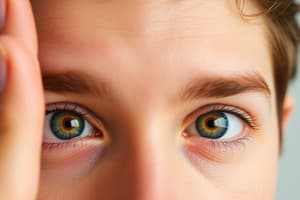Podcast
Questions and Answers
Which condition is characterized by a tendency of the eyes to deviate when fusion is blocked?
Which condition is characterized by a tendency of the eyes to deviate when fusion is blocked?
- Heterophoria (correct)
- Heterotropia
- Orthophoria
- Strabismus
What kind of deviation does a hypertropia describe?
What kind of deviation does a hypertropia describe?
- Downward displacement of one eye relative to the other
- Horizontal deviation of both eyes
- Upward displacement of one eye relative to the other (correct)
- Outward imbalance of the eyes
Which type of squint may be a result of a difference in refraction between the two eyes?
Which type of squint may be a result of a difference in refraction between the two eyes?
- Congenital strabismus
- Accommodative strabismus
- Anisometropic squint (correct)
- Aphakic strabismus
Which term describes a manifest deviation where the visual axes do not intersect at the point of fixation?
Which term describes a manifest deviation where the visual axes do not intersect at the point of fixation?
In which condition might one eye's image be suppressed at the cortical level?
In which condition might one eye's image be suppressed at the cortical level?
What anatomical feature is typically slightly temporal to the anatomical center of the posterior pole?
What anatomical feature is typically slightly temporal to the anatomical center of the posterior pole?
Which term refers to the condition where there is an upward latent imbalance of the eyes?
Which term refers to the condition where there is an upward latent imbalance of the eyes?
What is the most common form of strabismus regarding horizontal deviation?
What is the most common form of strabismus regarding horizontal deviation?
Which of the following statements about orthophoria is true?
Which of the following statements about orthophoria is true?
What primary factor may lead to decompensated phoria?
What primary factor may lead to decompensated phoria?
Flashcards
Binocular Single Vision (BSV)
Binocular Single Vision (BSV)
Normal vision where the two eyes work together to produce a single image.
Orthophoria
Orthophoria
Perfect alignment of the eyes in the absence of fusion effort.
Heterophoria
Heterophoria
A tendency for the eyes to deviate when fusion is blocked.
Esophoria
Esophoria
Signup and view all the flashcards
Exophoria
Exophoria
Signup and view all the flashcards
Heterotropia
Heterotropia
Signup and view all the flashcards
Strabismus
Strabismus
Signup and view all the flashcards
Hyperphoria
Hyperphoria
Signup and view all the flashcards
Hypotropia
Hypotropia
Signup and view all the flashcards
Visual Axis
Visual Axis
Signup and view all the flashcards
Study Notes
Strabismus Introduction
- Visual axis passes from the fovea through the nodal point to the fixation point.
- In normal binocular vision, visual axes intersect at the fixation point.
- Images are aligned by the fusion reflex and combined by binocular cells.
- Orthophoria: perfect ocular alignment in the absence of fusion stimulus (uncommon).
- Heterophoria: tendency for eyes to deviate when fusion is blocked (latent squint).
- Slight phoria is common and overcome by fusion reflex.
- Can be inward (esophoria) or outward (exophoria) imbalance.
- Decompensating phoria causes binocular discomfort (asthenopia) or double vision (diplopia).
- Heterotropia: manifest deviation where visual axes do not intersect at the fixation point.
- Images are misaligned, often causing double vision, or the image from the deviating eye is suppressed.
- Childhood squint, can be caused by failure of binocular fusion, oculomotor imbalance, or differing eye refraction (anisometropia).
Anatomical Axis and Angle Kappa
- Anatomical axis: passes from the posterior pole through the center of the cornea.
- Visual axis is usually slightly temporal to the anatomical axis, due to foveal location.
- Angle kappa: measures the angle between the visual and anatomical axes (usually about 5°).
- Angle kappa is positive when the fovea is temporal to the posterior pole center
- resulting in nasal corneal reflex displacement.
- Negative angle kappa is when the fovea is nasal to the center.
- Large angle kappa can mimic a squint (pseudosquint), particularly in conditions like retinopathy of prematurity.
Other Strabismus Factors
- Failure of fusion, can lead to heterotropia in adults or strabismus in children.
- Factors can include weaknesses or restrictions in extraocular muscles or nerve damage/weakness.
- Horizontal deviation (latent or manifest) is common strabismus type.
- Upward, downward displacement of eyes are called hypertropia/hypotropia and hyperphoria/hypophoria, respectively.
Studying That Suits You
Use AI to generate personalized quizzes and flashcards to suit your learning preferences.




